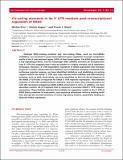| dc.contributor.author | Kim, Minlee | |
| dc.contributor.author | Kogan, Nicole E. | |
| dc.contributor.author | Slack, Frank J. | |
| dc.date.accessioned | 2016-05-23T17:36:40Z | |
| dc.date.available | 2016-05-23T17:36:40Z | |
| dc.date.issued | 2016-02 | |
| dc.date.submitted | 2015-08 | |
| dc.identifier.issn | 1949-2553 | |
| dc.identifier.uri | http://hdl.handle.net/1721.1/102629 | |
| dc.description.abstract | Multiple RNA-binding proteins and non-coding RNAs, such as microRNAs (miRNAs), are involved in post-transcriptional gene regulation through recognition motifs in the 3′ untranslated region (UTR) of their target genes. The KRAS gene encodes a key signaling protein, and its messenger RNA (mRNA) contains an exceptionally long 3′ UTR; this suggests that it may be subject to a highly complex set of regulatory processes. However, 3′ UTR-dependent regulation of KRAS expression has not been explored in detail. Using extensive deletion and mutational analyses combined with luciferase reporter assays, we have identified inhibitory and stabilizing cis-acting regions within the KRAS 3′ UTR that may interact with miRNAs and RNA-binding proteins, such as HuR. Particularly, we have identified an AU-rich 49-nt fragment in the KRAS 3′ UTR that is required for KRAS 3′ UTR reporter repression. This element contains a miR-185 complementary element, and we show that overexpression of miR-185 represses endogenous KRAS mRNA and protein in vitro. In addition, we have identified another 49-nt fragment that is required to promote KRAS 3′ UTR reporter expression. These findings indicate that multiple cis-regulatory motifs in the 3′ UTR of KRAS finely modulate its expression, and sequence alterations within a binding motif may disrupt the precise functions of trans-regulatory factors, potentially leading to aberrant KRAS expression. | en_US |
| dc.description.sponsorship | LUNGevity Foundation | en_US |
| dc.description.sponsorship | National Institutes of Health (U.S.) (Grant CA157749) | en_US |
| dc.language.iso | en_US | |
| dc.publisher | Impact Journals/National Center for Biotechnology Information (U.S.) | en_US |
| dc.relation.isversionof | http://dx.doi.org/10.18632/oncotarget.7599 | en_US |
| dc.rights | Creative Commons Attribution | en_US |
| dc.rights.uri | http://creativecommons.org/licenses/by/3.0/ | en_US |
| dc.source | Impact Journals/National Center for Biotechnology Information (U.S.) | en_US |
| dc.title | Cis-acting elements in its 3′ UTR mediate post-transcriptional regulation of KRAS | en_US |
| dc.type | Article | en_US |
| dc.identifier.citation | Kim, Minlee, Nicole Kogan, and Frank J. Slack. “Cis-Acting Elements in Its 3′ UTR Mediate Post-Transcriptional Regulation of KRAS.” Oncotarget (March 14, 2016). © 2016 Impact Journals, LLC | en_US |
| dc.contributor.department | Massachusetts Institute of Technology. Department of Biological Engineering | en_US |
| dc.contributor.mitauthor | Kogan, Nicole E. | en_US |
| dc.relation.journal | Oncotarget | en_US |
| dc.eprint.version | Final published version | en_US |
| dc.type.uri | http://purl.org/eprint/type/JournalArticle | en_US |
| eprint.status | http://purl.org/eprint/status/PeerReviewed | en_US |
| dspace.orderedauthors | Kim, Minlee; Kogan, Nicole; Slack, Frank J. | en_US |
| dspace.embargo.terms | N | en_US |
| mit.license | OPEN_ACCESS_POLICY | en_US |
